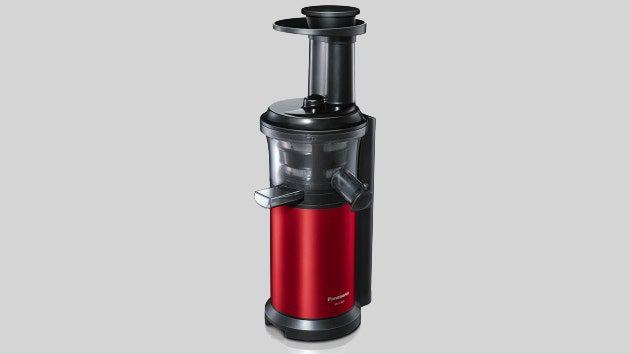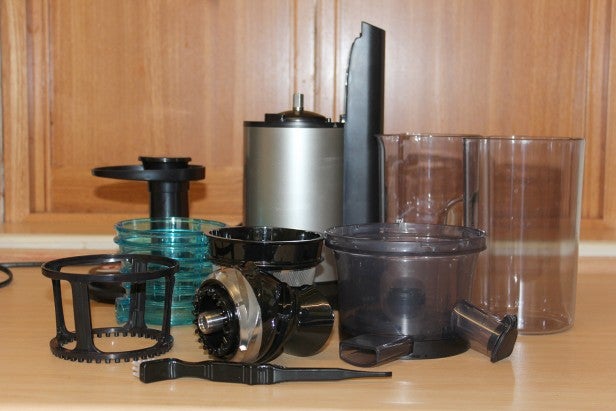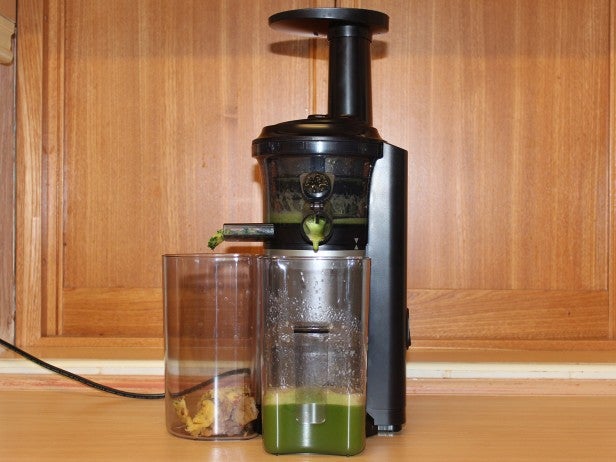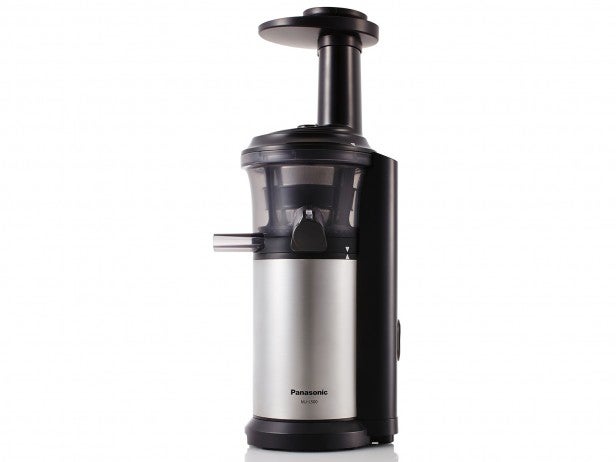Panasonic MJ-L500 Slow Juicer Review
Panasonic MJ-L500 Slow Juicer
Outstanding slow juicer and frozen dessert maker in one

Verdict
Pros
- Juices fresh and frozen
- Highly efficient juicing
- Compact
Cons
- Some parts not dishwasher-safe
- Multiple parts to assemble
- Limited recipe ideas
Key Specifications
- Review Price: £199.99
- Power: 150W
- Frozen attachment
- Cleaning brush
- Dimensions: H43.2 x W18.5 x D17.6cm
What is the Panasonic MJ-L500 Slow Juicer?
Compact, efficient and versatile, the MJ-L500 combines everything you’d want in a juicer. Using a technique of “slow juicing”, which squeezes fruit and vegetables at 45rpm rather than dicing and spinning at speed, it’s designed for maximum extraction with minimal effort. The lower speeds also result in reduced heat and air exposure, which means more nutrients in your juice and less separation.
The MJ-L500 also comes with a frozen attachment for making sorbets and frozen cocktails, plus it’s small enough to sit out on the worktop permanently. Unlike many juicers, it comes in a choice of colours too – silver, champagne and red.
Panasonic MJ-L500 Slow Juicer – Design and Features
Slow, or “macerating”, juicers were once hefty machines that hogged worktop space, but the MJ-L500 is barely a distant cousin. Upright and neat, it consists of a cylinder-like base, on top of which sits a juicing bowl that contains a rotating brush, stainless-steel-tipped squeezing screw and filter. A lid with a feeding tube and pusher locks into place above, and although the tube is narrow, this helps to prevent the juicer from being overloaded with large chunks of fruit or veg.
Related: Braun J500 Spin Juicer review
Two spouts jut out from the bowl – one for pulp and one for juice or processed frozen fruit – and a jug and pulp container is provided to receive each. To prevent any drips, the juicing spout features a hinged cap that plugs in to stop the flow. There’s a single rocker switch on the side – turn it one way to switch on the machine, or the other to turn it off; or it can be held in reverse to clear clogs.
Panasonic MJ-L500 Slow Juicer – Usability
While the assembled MJ-L500 is compact, there are a fair few parts that make up the unit. Fortunately, the diagram-style instructions and arrows on the individual parts help to minimise the fuss of putting it together. Where the instructions fell down was with a lack of inspirational recipe ideas – there are some suggestions of fruit and vegetable combinations, but beyond that we were left to our own devices.
We started by juicing an apple, which needed to be chopped into small chunks to fit into the feeding tube. Despite being called a Slow Juicer, there was little waiting around for the juice; it flowed out smoothly and quickly, with no spurting or drips. There was also no need to use the pusher, as the pieces dropped down by themselves and were processed properly.
Thanks to a measuring scale on the side of the jug, it was easy to see how much juice was being made. There was a layer of foam on top of the apple juice, but it was otherwise clear and had a fresh, crisp taste.
A lid for the jug would have been a useful addition for storage in the fridge, plus there wasn’t a separator to keep the foam out of the juice as it was being poured.
However, the machine juiced very efficiently, since the pulp was firmly compacted and dry to the touch. Sealing the juice spout with the cap prevented drips effectively.

Next, we juiced some spinach with a slice of pineapple – the latter added to help prevent the leaves from becoming wrapped around the screw. This produced about 200ml of juice, a good yield for the amount of fruit and vegetables. While one or two of the spinach leaves did become wrapped around the screw, the majority were juiced well, producing a sweet green drink that showed no sign of separating – even after standing.
Finally, we finished by inserting the frozen attachment. We used frozen slices of banana and blueberries to make a dessert. While the fruit had been frozen for several hours, the instructions advised not to process straight from the freezer, so we waited for around 20 minutes while it thawed.
When added to the juicer, the fruit defrosted further, so the consistency of the final dessert was not as sorbet-like as desired. It suggests that some experimentation with the degree of “frozenness” required might be in order.
Once disassembled, cleaning the parts of the machine wasn’t difficult – but only some are dishwasher-safe. The pointed handle of the cleaning brush was indispensable for removing pulp.
Related: Sage The Nutri Juicer BJE200 review
Should I buy the Panasonic MJ-L500 Slow Juicer?
Lack of recipes aside, the MJ-L500 is as good for newbie juicers as it is for those who are looking to upgrade from a centrifugal machine or want an appliance that has more functionality. Not only does it take up barely any space, it packs in a lot for its price and gives an excellent yield.
The ability to make frozen desserts makes it invaluable for those who want to eat a bit more healthily, or help their kids get their five-a-day. In addition, since its compact size means it can sit on the worktop, you’re sure to get more use out of it than one that lives in a cupboard.
Verdict
As good as having a juice bar on your doorstep, with a frozen dessert parlour next door – the MJ-L500 makes getting your five-a-day a cinch.

